Introduction
The U.S. water system is a sprawling, complex series of networks with the mission of providing safe, reliable, and cheap drinking water to hundreds of millions of people. It is also tasked with managing wastewater and contributing to hydropower, agricultural irrigation, flood control, and industries such as oil, gas, and mining.
This network is under stress from growing populations, aging infrastructure, extreme weather patterns, and regulatory failures. While authorities struggle with public-health hazards, water utilities face budget squeezes, rising consumer costs, and unmet investment needs. Western states wrangle over water rights as drought and overuse deplete their rivers, reservoirs, and aquifers. Meanwhile, debate continues over the proper role of the federal government in regulating, and funding, the nation’s water infrastructure—with access to water for drinking, as well as growing food and myriad other forms of commerce, at stake.
What role does water play in the U.S. economy?
Water access is central to every aspect of the U.S. economy. Power generation requires massive amounts of water for cooling purposes, as do the technology and manufacturing sectors; however, much of this water is returned to its source. Agriculture, especially crops and livestock, rely on large quantities of water, as do extractive industries such as mining, refining, and fracking. A 2020 study by water utilities, engineers, and advocacy groups estimated [PDF] that making all the needed investments in U.S. water infrastructure would add $4.5 trillion and eight hundred thousand jobs to the U.S. economy by 2039.
U.S. per capita water consumption is among the highest in the world, amounting to more than twice that of other industrialized nations such as Germany, Japan, and the United Kingdom.
 According to U.S. Geological Survey (USGS) calculations [PDF] for 2015, the most recent year for which it compiled data, power generation was the biggest drain on U.S. water bodies, accounting for 41 percent of withdrawals, although nearly all that water was recycled and thus not “consumed.” The next largest use, irrigation, made up around 37 percent of withdrawals, but it consumed—through evaporation or other loss—nearly seventeen times as much water as power generation. Public consumption made up 12 percent, while mining and industry composed another 6 percent.
According to U.S. Geological Survey (USGS) calculations [PDF] for 2015, the most recent year for which it compiled data, power generation was the biggest drain on U.S. water bodies, accounting for 41 percent of withdrawals, although nearly all that water was recycled and thus not “consumed.” The next largest use, irrigation, made up around 37 percent of withdrawals, but it consumed—through evaporation or other loss—nearly seventeen times as much water as power generation. Public consumption made up 12 percent, while mining and industry composed another 6 percent.
 States whose economies are particularly tied to agriculture depend even more heavily on reliable water supplies, making them particularly susceptible to drought. California, the country’s largest food producer, uses about three-quarters of its freshwater for agricultural purposes. Severe drought cost the state nearly twenty thousand jobs and over $3 billion in economic losses between 2020 and 2022, the driest three-year period in California history.
States whose economies are particularly tied to agriculture depend even more heavily on reliable water supplies, making them particularly susceptible to drought. California, the country’s largest food producer, uses about three-quarters of its freshwater for agricultural purposes. Severe drought cost the state nearly twenty thousand jobs and over $3 billion in economic losses between 2020 and 2022, the driest three-year period in California history.
Keep reading on Council on Foreign Relations.
Water flows between mesas in Arizona. Joshua Lott/The Washington Post/Getty Images




